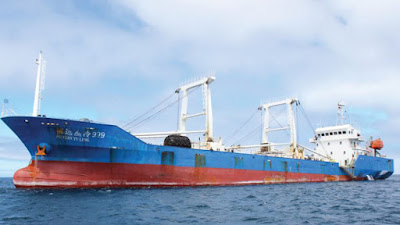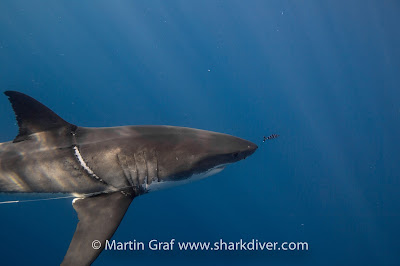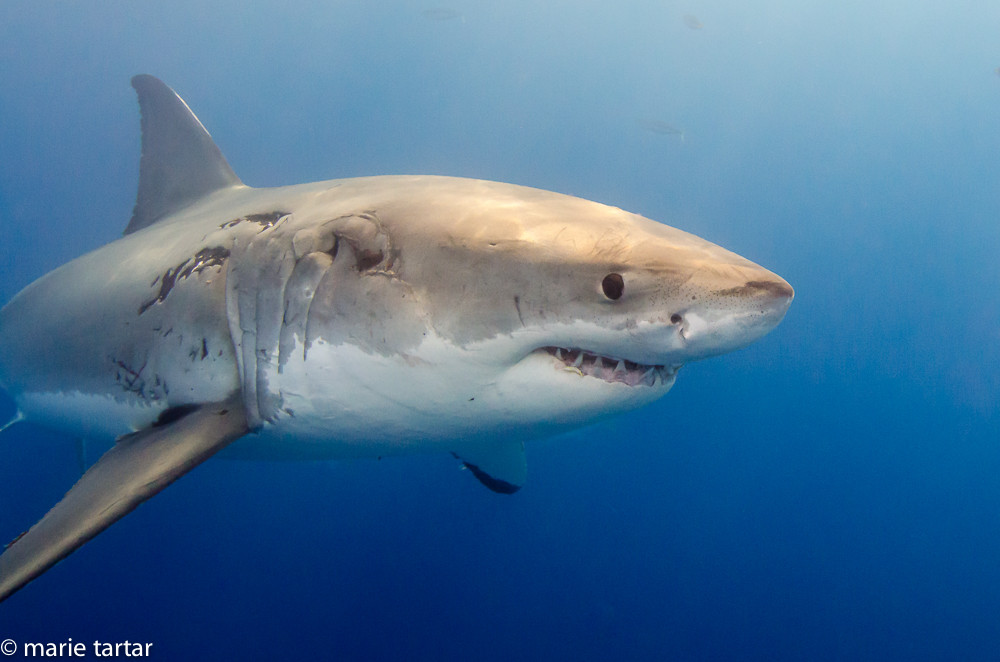I started SCUBA diving and spear-fishing at Guadalupe Island in 1996, 5 years before we started shark diving there. It is during that time that we discovered the Great White Sharks that are aggregating at there. At first it was just the occasional encounter, mainly while spear-fishing, but over the years those encounters grew in frequency and it was not unheard of to see a GWS while SCUBA diving.
My first encounter with a GWS happened at the south end of Guadalupe, while working as a divemaster, watching some divers. I noticed something moving behind me and when I turned I was face to face with a Great White Shark. It calmly swam by me, continued away from me for about 100' or so and slowly turned around, swimming right back towards me and passing just inches from my body. Strangely, it was not a scary experience, but rather a "wow!" kind of moment. It wasn't at all what I expected from seeing a GWS up close and personal and it started my love for (some people might say my obsession with) these awesome animals.
In 2001 we started our first season of cage diving at Guadalupe. At the time the Island was not a biosphere and there were no rules and regulations regarding diving with sharks and even fishing for Great White Sharks was legal. The operators of the cage diving boats got together and created the Guadalupe Island Conservation Fund, a non profit organization with the goal of helping create protections for the sharks and fund research that is critical for their protection.
In 2003 a young graduate student by the name of Mauricio Hoyos started studying the sharks at Guadalupe. He was living on the Island for 3 months at a time and the shark diving boats supported him with money, supplies as well as a hot meal and warm bed for the night when we were at the Island. Of course the world now knows him as Dr. Hoyos from various shark programs on TV as he continues to do research at Guadalupe.
In 2005 Guadalupe Island became a biosphere, the equivalent of a national park in the US. That designation allowed the government to establish rules and regulations for using the Island and also created revenues from the sale of permits for the boats and entrance fees for everyone visiting the Island. Every year thousands of shark enthusiasts visit Guadalupe to admire these animals up close and personal. The popularity of the White Sharks, combined with the typically crystal clear waters at the Island, have established Guadalupe as the premier White Shark diving site in the world. Numerous TV programs filmed there also made Guadalupe a household word for anyone watching Shark Week or Nat. Geo's Shark Fest on TV.
It wasn't until 2007 that the Great White Shark became a protected species in all of Mexico. Unfortunately, the enforcement of that ban was difficult, since there is only a small naval detachment at the south end of Guadalupe and poachers were still trying to catch these sharks. During the early years of the ban on White Shark fishing the shark diving boats "discouraged" more than a few boats that were illegally targeting these sharks. Over the years, the wannabe poachers have learned that they can't easily get away with poaching at Guadalupe because all the shark boats were keeping a watchful eye on the area.
That brings us to the present. Because of covid-19 the Island has been closed. That means that right now, with the Great White Shark aggregation season underway, there is no deterrent for any poacher that wants to kill these sharks. We already know from other locations like the Galapagos where a Chinese fishing trawler poached 300 tons of fish and Fiji, where poachers used the covid-19 shutdown of the shark diving activities to go and poach in the Shark Reef Marine Reserve, that when there is no effective barrier for illegal fishing, that the poachers have free reign.
Can you imagine what would happen if a Chinese fishing vessel is targeting the Great White Sharks at Guadalupe? Fins from Great White Sharks are highly prized and that is without the value of the jaws and teeth that can fetch as much as $1k PER TOOTH! An action like this could wipe out the entire population of Great White Sharks at Guadalupe in a week!
For me these sharks are more than just another fish. Over the last 20 years of diving with them, I've gotten attached to not only Great White Sharks in general, but to numerous individuals, some of which I've seen every year since 2001. Lucy, Chugey, Scarboard, Tzitzimitl, Bruce, Geoff Nuttal, Luca Arnone, Slash Fin, Screaming Mimi, Crazy Tryss, Mau, Jacques, Thor etc. etc. I worry about them.
We have over 360 individual Great White Sharks in our database that is maintained by Nicole Lucas from the Marine Conservation Science Institute That database is maintained with photos from the cage divers and Shark Diver even has 4 trips a year that are specifically designed as a fund raiser to help keep that database up to date.
We hope that the Mexican authorities will reopen the Guadalupe biosphere
as soon as safely possible, so that we can go out there once more and
keep and eye on our sharks. Their lives may literally depend on it!
Cheers,
Martin Graf
CEO Shark Diver
About Shark Diver.
As a global leader in commercial shark diving and conservation initiatives Shark Diver has spent the past decade engaged for sharks around the world. Our blog highlights all aspects of both of these dynamic and shifting worlds. You can reach us directly at crew@sharkdiver.com.












































